
In gamma-ray astronomy, gamma-ray bursts (GRBs) are immensely energetic explosions that have been observed in distant galaxies, being the brightest and most extreme explosive events in the entire universe, as NASA describes the bursts as the "most powerful class of explosions in the universe". They are the most energetic and luminous electromagnetic events since the Big Bang. Gamma-ray bursts can last from ten milliseconds to several hours. After the initial flash of gamma rays, an "afterglow" is emitted, which is longer lived and usually emitted at longer wavelengths.
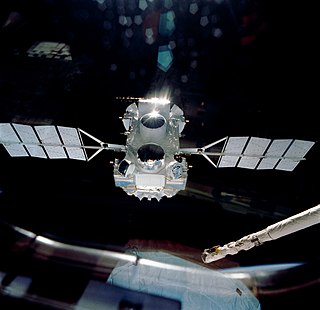
The Compton Gamma Ray Observatory (CGRO) was a space observatory detecting photons with energies from 20 keV to 30 GeV, in Earth orbit from 1991 to 2000. The observatory featured four main telescopes in one spacecraft, covering X-rays and gamma rays, including various specialized sub-instruments and detectors. Following 14 years of effort, the observatory was launched from Space Shuttle Atlantis during STS-37 on April 5, 1991, and operated until its deorbit on June 4, 2000. It was deployed in low Earth orbit at 450 km (280 mi) to avoid the Van Allen radiation belt. It was the heaviest astrophysical payload ever flown at that time at 16,300 kilograms (35,900 lb).
Andreja Gomboc, is a Slovenian astrophysicist.
Reuven Ramaty (1937—2001) was a Hungarian astrophysicist who worked for 30 years at NASA's NASA Goddard Space Flight Centre. He was a leader in the fields of solar physics, gamma-ray line spectrometry, nuclear astrophysics, and low-energy cosmic rays. Ramaty was a founding member of NASA's High Energy Solar Spectroscopic Imager which has now been renamed the Reuven Ramaty High Energy Solar Spectroscopic Imager in his honour. This was the first space mission to be named after a NASA scientist and was operational from 2002 until 2018. The Online Archive of California holds over 400 entries for documents, papers and photographs published by and of Ramaty and his work. Ramaty made many contributions in the field of astrophysics and solar physics. He was given the Goddard Lindsay Award in 1980 and had a tribute dedicated to his work at the University of Maryland in 2000.

Cornelis A. "Neil" Gehrels was an American astrophysicist specializing in the field of gamma-ray astronomy. He was Chief of the Astroparticle Physics Laboratory at NASA's Goddard Space Flight Center (GSFC) from 1995 until his death, and was best known for his work developing the field from early balloon instruments to today's space observatories such as the NASA Swift mission, for which he was the principal investigator. He was leading the WFIRST wide-field infrared telescope forward toward a launch in the mid-2020s. He was a member of the National Academy of Sciences and the American Academy of Arts and Sciences.
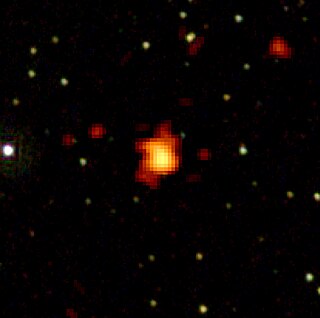
GRB 080916C is a gamma-ray burst (GRB) that was recorded on September 16, 2008, in the Carina constellation and detected by NASA's Fermi Gamma-ray Space Telescope. The burst lasted for 23 minutes. It is one of the most extreme gamma-ray bursts ever recorded, and was the most energetic gamma-ray burst ever recorded, until GRB 221009A was recorded in 2022. The explosion had the energy of approximately 9000 type Ia supernovae if the emission was isotropically emitted, and the gas jets emitting the initial gamma rays moved at a minimum velocity of approximately 299,792,158 m/s, making this blast one of the most extreme recorded.

The Gamma-Ray Burst Optical/Near-Infrared Detector (GROND) is an imaging instrument used to investigate Gamma-Ray Burst afterglows and for doing follow-up observations on exoplanets using transit photometry. It is operated at the 2.2-metre MPG/ESO telescope at ESO's La Silla Observatory in the southern part of the Atacama desert, about 600 kilometres north of Santiago de Chile and at an altitude of 2,400 metres.
The history of gamma-ray began with the serendipitous detection of a gamma-ray burst (GRB) on July 2, 1967, by the U.S. Vela satellites. After these satellites detected fifteen other GRBs, Ray Klebesadel of the Los Alamos National Laboratory published the first paper on the subject, Observations of Gamma-Ray Bursts of Cosmic Origin. As more and more research was done on these mysterious events, hundreds of models were developed in an attempt to explain their origins.
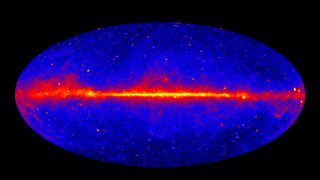
Gamma-ray astronomy is a subfield of astronomy where scientists observe and study celestial objects and phenomena in outer space which emit cosmic electromagnetic radiation in the form of gamma rays, i.e. photons with the highest energies at the very shortest wavelengths. Radiation below 100 keV is classified as X-rays and is the subject of X-ray astronomy.

GRB 991216, nicknamed the Beethoven Burst by Dr. Brad Schaefer of Yale University, was a gamma-ray burst observed on December 16, 1999, coinciding with the 229th anniversary of Ludwig van Beethoven's birth. A gamma-ray burst is a highly luminous flash associated with an explosion in a distant galaxy and producing gamma rays, the most energetic form of electromagnetic radiation, and often followed by a longer-lived "afterglow" emitted at longer wavelengths.
GRB 011211 was a gamma-ray burst (GRB) detected on December 11, 2001. A gamma-ray burst is a highly luminous flash associated with an explosion in a distant galaxy and producing gamma rays, the most energetic form of electromagnetic radiation, and often followed by a longer-lived "afterglow" emitted at longer wavelengths.

GRB 101225A, also known as the "Christmas burst", was a cosmic explosion first detected by NASA's Swift observatory on Christmas Day 2010. The gamma-ray emission lasted at least 28 minutes, which is unusually long. Follow-up observations of the burst's afterglow by the Hubble Space Telescope and ground-based observatories were unable to determine the object's distance using spectroscopic methods.

Kenneth John Frost was a pioneer in the early space program, designing and flying instruments to detect and measure X-rays and gamma-rays in space, primarily from the Sun. He was the first to suggest the use of an active scintillation shield operated in electronic anticoincidence with the primary detector to reduce the background from cosmic ray interactions, an innovation that made sensitive hard X-ray and gamma-ray astronomy possible. He was an American astrophysicist at Goddard Space Flight Center working as a civil servant for the National Aeronautics and Space Administration. During his career, he was the project scientist of the Solar Maximum Mission, principal investigator of six science instruments, the head of the Solar Physics Branch, and the associate director of Space Sciences.

Hakkı Boran Ögelman was a Turkish physicist and astrophysicist. He was an expert on gamma ray astronomy, the physics of neutron stars, and solar energy and worked on several key topics in modern astrophysics. He made many contributions to high energy astrophysics. In his early professional career he engaged in the SAS-II Small Gamma Ray Astronomy Satellite experiment development, data analysis, and first detection and imaging of our universe in gamma rays with his NASA colleagues, as well as in other fields of physics. His main interests in the field of astrophysics were the study of gamma ray astronomy and compact objects such as neutron stars and pulsars. Ögelman worked at NASA Goddard Space Flight Center, Middle East Technical University (METU) in Ankara, Turkey, Çukurova University in Adana, Turkey, Max Planck Institute (MPI) at Garching, Germany and the University of Wisconsin.

Rita M. Sambruna Commander OMRI (Hon) is an Italian-American astrophysicist and is the Deputy Director of the Astrophysics Science Division at National Aeronautics and Space Administration's (NASA) Goddard Space Flight Center. From September 2022 to May 2023, she was the Acting Deputy Director of the Science Exploration Directorate at Goddard. Rita held the Clare Boothe Luce Professorship in Physics and Astronomy at George Mason University in 2000-2005.
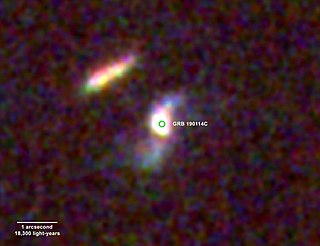
GRB 190114C was an extreme gamma-ray burst explosion from a galaxy 4.5 billion light years away (z=0.4245; magnitude=15.60est) near the Fornax constellation, that was initially detected in January 2019. The afterglow light emitted soon after the burst was found to be tera-electron volt radiation from inverse Compton emission, identified for the first time. According to the astronomers, "We observed a huge range of frequencies in the electromagnetic radiation afterglow of GRB 190114C. It is the most extensive to date for a gamma-ray burst." Also, according to other astronomers, "light detected from the object had the highest energy ever observed for a GRB: 1 Tera electron volt (TeV) -- about one trillion times as much energy per photon as visible light"; another source stated, "the brightest light ever seen from Earth [to date].".
Bing Zhang is a Chinese astrophysicist and professor at the University of Nevada, Las Vegas. He is best known for his research in gamma-ray bursts, fast radio bursts, and other high-energy astrophysical phenomena. He is the author of the book The Physics of Gamma-Ray Bursts.
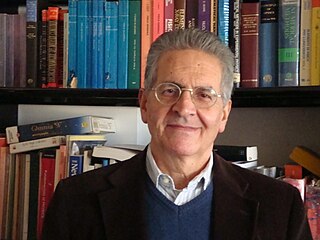
Filippo Frontera is an Italian astrophysicist and professor, who deals with astronomical investigations on celestial gamma-rays.

GRB 221009A was an extraordinarily bright and very energetic gamma-ray burst (GRB) jointly discovered by the Neil Gehrels Swift Observatory and the Fermi Gamma-ray Space Telescope on October 9, 2022. The gamma-ray burst was ten minutes long, but was detectable for more than ten hours following initial detection. Despite being around 2.4 billion light-years away, it was powerful enough to affect Earth's atmosphere, having the strongest effect ever recorded by a gamma-ray burst on the planet. The peak luminosity of GRB 221009A was measured by Konus-Wind to be ~ 2.1 × 1047 W and by Fermi Gamma-ray Burst Monitor to be ~ 1.0 × 1047 W over its 1.024s interval. A burst as energetic and as close to Earth as 221009A is thought to be a once-in-10,000-year event. It was the brightest and most energetic gamma-ray burst ever recorded, with some dubbing it the BOAT, or Brightest Of All Time.














